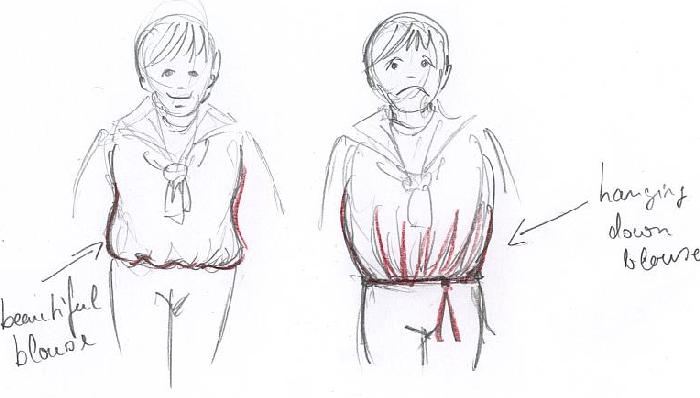
Blouse Construction: Drawstring Effectiveness

Figure 1.--A reader asks why the blouse did not fall down given the active life of boys. It may have on some occassions. We believe, however, that the added width at the waist becaise of the waisline of the kilt or pants was two wide gor the blouse to fall down over.
|
We understand how drawstring blouses worked. We are not sure given the fact that boys wete likely to be playing and running about,why the blouses even with the drawstrings tied would not gradually fall down. A reader writes, "I think I understand what is meant with a drawstring and how the blose bloused over the waistline. But how did they prevent this drawstring from gradually falling down? Please see the attached drawing." Given the active life of boys, we know that even when dressed up there would have been a lot of motion and tugs and pulls. The bouses may have fallen down on occassion, but we do not ghink that this was common. HBC believes tthat the reason the drawstring generally worked was that it was tied above the waisline of the lower garment, either panys (trousers) or kilt. Now boys this age and even younger school-age boys generally did not have defined waistlines. The pants or kilt shirt, however did add to the waisline. Thus if the drawstring was well tied and knotted above the lower garment waistline, it would not fall below the waistline. Of course the images we see are mostly formal studio portaits and mother would have made sure that a boy was done up nicely. But we have noted noted feferences in available literarure about a boy's blouse falling down.
HBC

Navigate the Boys' Historical Clothing Web Site:
[Return to the Main blouse construction page]
[Introduction]
[Activities]
[Biographies]
[Chronology]
[Cloth and textiles]
[Clothing styles]
[Countries]
[Topics]
[Bibliographies]
[Contributions]
[FAQs]
[Glossaries]
Images
[Satellite sites]
[Tools]
[Boys' Clothing Home]
Created: 11:21 PM 2/7/2005
Last updated: 11:21 PM 2/7/2005



